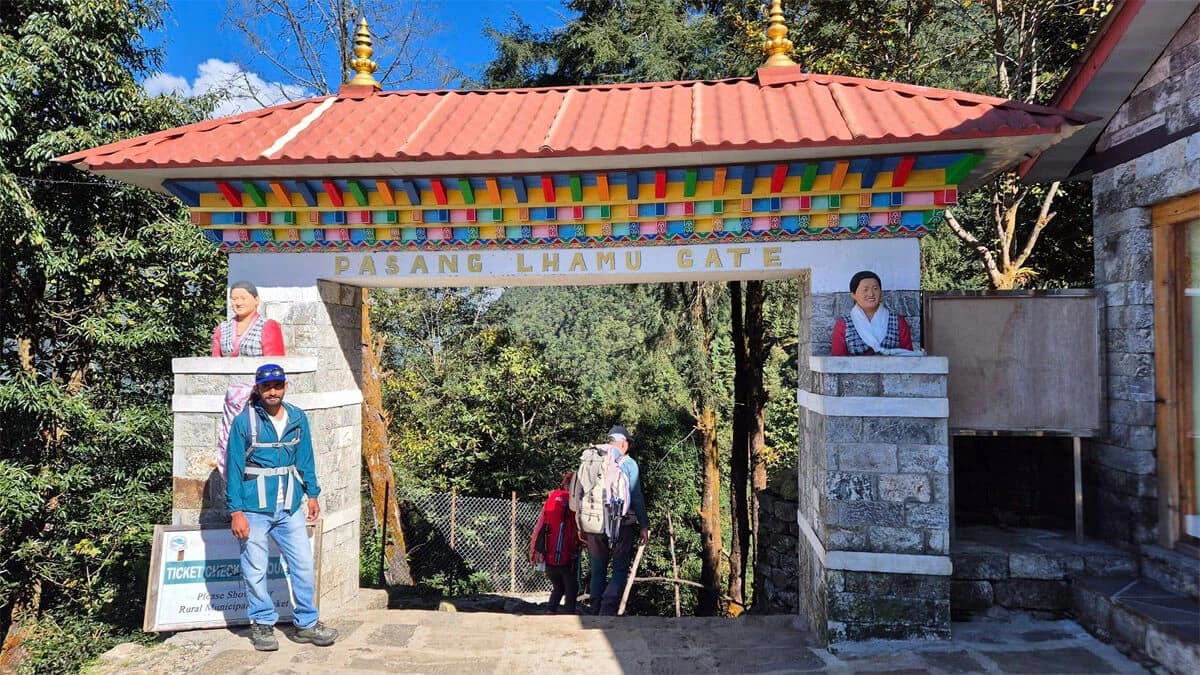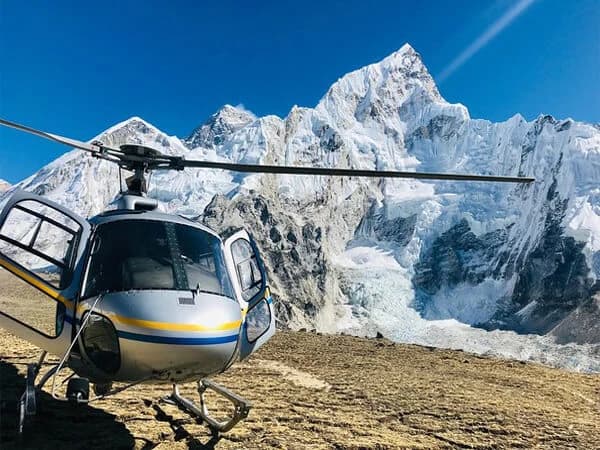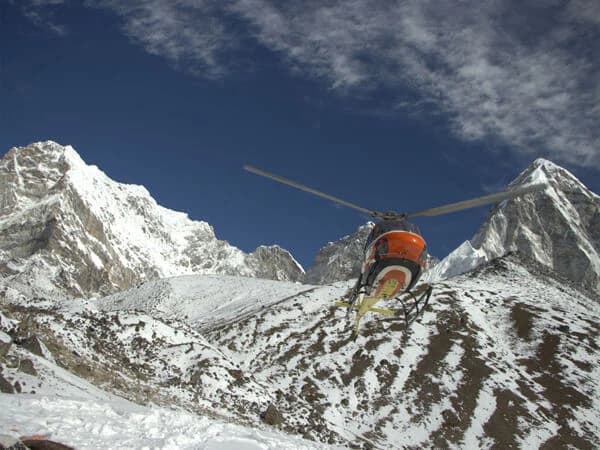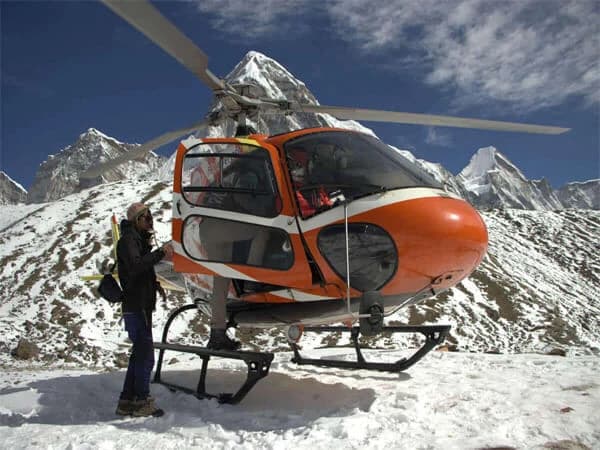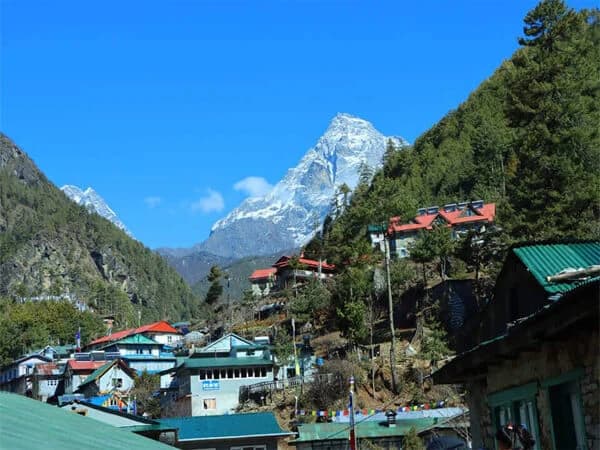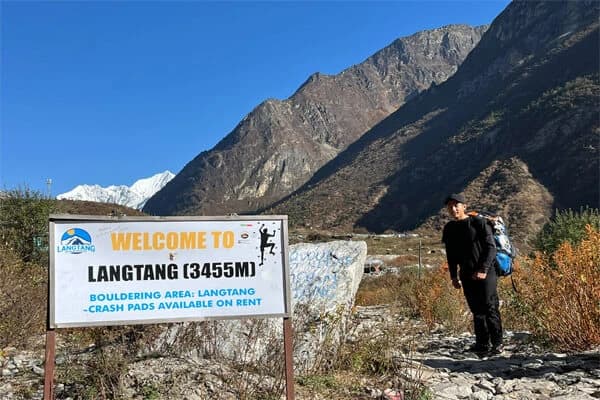The Everest Base Camp (EBC) helicopter tour is a dream for many trekkers and adventure seekers. It offers an exciting way to experience the greatness of the Himalayas, the iconic Everest, and the surrounding peaks in just a few hours, rather than weeks required for a full trek. This blog includes a guide to help you navigate everything you need to know about the Everest Base Camp helicopter tour, from what to expect, the best time to go, planning the tour, food and accommodation, culture, and people of the Himalayan region.
The ultimate guide to Everest Base Camp Helicopter tour
The helicopters used for the EBC tour are specially designed to operate in high-altitude environments, ensuring safety, reliability, and comfort during your flight. These helicopters are chosen for their engineering, ability to handle thin air at high altitudes, and excellent maneuverability even in the Everest region's extreme conditions and challenging terrain.
Why Everest Base Camp is a unique destination for helicopter tours?
Everest Base Camp (EBC) is a truly unique destination for a helicopter tour due to its combination of natural beauty, iconic status, and accessibility challenges. At an altitude of 5,364 meters, EBC lies at the foot of the world’s highest mountain, Mount Everest, making it one of the most popular destinations for adventure seekers.
The magnitude of the surrounding peaks including Everest, Lhotse, and Nuptse, is awe-inspiring, and a helicopter tour offers the rare opportunity to witness this grandeur from an extraordinary vantage point. While trekking to EBC takes weeks of preparation and endurance, a helicopter tour provides an efficient, comfortable, and thrilling way to experience this Himalayan wonder in just a few hours.
You Should Also Know About Everest Base Camp Trek VS Everest Base Camp Helicopter Tour
Moreover, EBC’s remote location, accessible only by foot or air, enhances its mystique. The ability to land at either EBC or Kala Patthar, a scenic vantage point, allows travelers to set foot in a region known for its extreme conditions and breathtaking beauty. This combination of aerial splendor, iconic status, and the chance to touch down at Everest’s doorstep makes EBC a unique and unforgettable helicopter tour destination.
When is the best time to visit
The best time for an Everest Base Camp helicopter tour is generally similar to the prime trekking seasons for EBC:
Spring (March to May): The weather is clear, offering great visibility of the mountains. Temperatures are moderate, and the snow has melted at lower altitudes, revealing vibrant greenery and blooming rhododendrons.
Autumn (September to November): This is another excellent time for the tour, with crystal-clear skies, stable weather, and moderate temperatures. Autumn also offers stunning views of the surrounding mountains.
Winter (December to February): While you can still take the tour, be prepared for freezing temperatures and potentially cloudy weather. The views can be spectacular, with fresh snow covering the peaks, but the cold can make it less comfortable.
Monsoon (June to August): This is the least favorable time due to frequent rain and poor visibility. Flights can be delayed or canceled because of adverse weather conditions.
For the best experience, aim for spring or autumn when the skies are clear, and the visibility of the Himalayas is at its peak.
Permits and Fees for the Everest Base Camp Helicopter Tour
A helicopter tour to Everest Base Camp (EBC) requires certain permits due to its operation within protected national parks and high-altitude areas. Here’s what you need to know about the permits and fees for an EBC helicopter tour:
Sagarmatha National Park Entry Permit
Sagarmatha National Park is a UNESCO World Heritage Site. All visitors to the park, whether by foot or air, are required to obtain a Sagarmatha National Park Entry Permit.
Cost: NPR 3,000 (approximately USD 25) per person for foreign nationals
The permit can be acquired in Kathmandu or at the entrance to the park, usually handled by the trekking or helicopter tour company.
Khumbu Pasang Lhamu Rural Municipality Permit
In addition to the national park permit, visitors to the Everest region must also obtain a Khumbu Pasang Lhamu Rural Municipality Permit. This local permit is mandatory for all travelers entering the Khumbu region.
Cost: NPR 2,000 (approximately USD 15) per person
This permit can be issued in Lukla or Kathmandu, typically arranged by your helicopter operator or trekking agency.
Helicopter Landing Fees
Landing at certain high-altitude locations like Everest Base Camp or Kala Patthar incurs landing fees. These fees are typically included in the overall cost of your helicopter tour, which the tour operator handles. The exact fee depends on the landing site and the helicopter company’s arrangements.
Tour operators like Nepal Trekking Routes typically handle all permits and fees for you, ensuring a smooth and hassle-free experience.
Planning Your Trip

How to get to EBC by helicopter
To get to Everest Base Camp (EBC) by helicopter, you’ll depart from Kathmandu’s Tribhuvan International Airport. The helicopter flies over the scenic Himalayan range, offering stunning aerial views of mountains, valleys, and villages.
A brief stop for refueling may occur at Lukla, the gateway to Everest. From there, the helicopter continues its journey, typically landing at either Everest Base Camp (5,364 meters) or Kala Patthar (5,545 meters) for better views of Mount Everest. After a short stay, you’ll fly back, often stopping at the Everest View Hotel for breakfast before returning to Kathmandu.
Choosing the right trekking agency is crucial to ensuring a safe and enjoyable helicopter tour. Nepal Trekking Routes stands out as a trusted local agency that offers personalized services and extensive knowledge of the Everest Region.
Essential gear and packing list
For an Everest Base Camp helicopter tour, pack light but essential gear for the high-altitude conditions. Here’s a quick list:
- Warm Clothing: Layered clothing including a down jacket, thermal wear, gloves, and a beanie.
- Sunglasses and Sunscreen: To protect from UV rays at high altitudes.
- Sturdy Footwear: Lightweight hiking boots or sturdy sneakers for walking on uneven terrain.
- Camera/Phone: For capturing stunning views (bring extra batteries).
- Water Bottle: Stay hydrated at high altitudes.
- Personal Medication: Altitude sickness pills or any personal meds.
- Pack light but be prepared for cold and sunny conditions.
Acclimatization and Health Considerations
The Everest Base Camp (EBC) helicopter tour offers a quick and efficient way to experience the breathtaking beauty of the Himalayas. However, health and acclimatization considerations are important due to the high altitudes. Here are some key points to keep in mind:
Understanding Altitude Sickness
Even though you’ll ascend rapidly by helicopter, you’ll still be exposed to high altitudes, where the air is thinner and oxygen levels decrease. Altitude sickness can occur at elevations above 2,500 meters (8,200 feet) and may cause symptoms such as headaches, nausea, dizziness, and fatigue. Awareness of these symptoms is essential for your health and comfort.
Hydration
Staying hydrated is crucial at high altitudes. Drink plenty of water before, during, and after your flight to help your body adapt. Dehydration can worsen altitude sickness and make you feel worse.
Rest and Nutrition
Before your tour, ensure you are well-rested and have eaten a balanced meal. Consuming carbohydrates and avoiding heavy, fatty foods can help maintain energy levels and overall well-being.
Consulting a Doctor
If you have pre-existing health conditions or concerns about altitude sickness, consult a healthcare professional before going on the tour. They may recommend medication to help acclimatize and mitigate symptoms.
Listen to Your Body
During the short stops at Everest Base Camp or Kala Patthar, pay attention to how your body reacts. If you experience severe symptoms of altitude sickness, inform your guide or pilot immediately. Safety should always be the priority.
Plan for Flexibility
Be prepared for potential weather-related delays, which may lead to extended time at altitude. Understanding this will help you mentally prepare and adjust your plans accordingly.
By taking these acclimatization and health considerations seriously, you can maximize your enjoyment and safety during the incredible experience of an EBC helicopter tour.
Touring Everest Base Camp
Itinerary of the Everest Base Camp Helicopter Tour
The Everest Base Camp (EBC) helicopter tour is a thrilling adventure that allows trekkers and travelers to experience the majestic beauty of the Himalayas in a fraction of the time it would take on foot. Below is a detailed itinerary that outlines what to expect during this unforgettable journey.
Arrival in Kathmandu
Arrive at Tribhuvan International Airport in Kathmandu, the vibrant capital of Nepal. You’ll be greeted by your local trekking agency, Nepal Trekking Routes, which will assist with any necessary arrangements and provide a briefing about your upcoming helicopter tour.
Spend the evening exploring the bustling streets of Thamel, sampling local cuisine, and shopping for last-minute gear or souvenirs. Enjoy a traditional Nepali dinner at a local restaurant.
Helicopter Tour to Everest Base Camp
Early Morning: Departure from Kathmandu
5:30 AM: Arrive at the helicopter departure point at Tribhuvan International Airport. After a safety briefing, you’ll board the helicopter. Be sure to dress in layers, as temperatures can be chilly at high altitudes.
7:30 AM: Take off for the breathtaking flight to Everest Base Camp. The helicopter will fly over stunning landscapes, including terraced fields, picturesque villages, and rugged mountains. Keep your camera ready for panoramic views of the Himalayan range.
En Route: Scenic Stops
Lukla Stop (Optional): A quick stop may be made at Lukla for refueling and to pick up additional passengers, giving you a glimpse of this famous gateway to the Everest region.
Arrival at Everest Base Camp
9:00 AM: Land at Everest Base Camp (5,364 meters) or Kala Patthar (5,545 meters), depending on weather conditions. If you land at EBC, you’ll be surrounded by climbers preparing for their ascent and stunning views of the Khumbu Icefall.
9:00 AM - 9:30 AM: Spend approximately 15-30 minutes at EBC or Kala Patthar. Take in the breathtaking views of Mount Everest, Lhotse, and Nuptse. This is a great time to capture photos and soak in the incredible atmosphere.
Breakfast Stop at Everest View Hotel
9:30 AM: Depart from EBC or Kala Patthar and fly to the Everest View Hotel for a breakfast stop. Here, you’ll enjoy a delicious meal while overlooking the magnificent mountains.
Return Flight to Kathmandu
12:00 PM: Begin the return journey to Kathmandu, retracing your flight path over the stunning landscapes.
01:00 PM: Arrive back in Kathmandu. Your pilot will ensure a safe landing as you soak in the last views of the Himalayas.
Afternoon:
After your return, the rest of the day is yours to relax. You may choose to visit local attractions such as the Swayambhunath Stupa (Monkey Temple) or Pashupatinath Temple if time permits.
Evening:
Enjoy a celebratory dinner at a local restaurant with your travel companions, sharing stories and memories from your helicopter tour.
Optional Extensions
If you wish to extend your adventure, consider adding a few extra days in Kathmandu to explore its rich cultural heritage or even embark on a short trek in the nearby Langtang or Gosaikunda regions.
The Everest Base Camp helicopter tour provides an incredible opportunity to experience the beauty of the Himalayas without the strenuous trek. With this itinerary, trekkers can expect an unforgettable journey that combines breathtaking views, cultural insights, and the thrill of flying close to the world’s highest peaks.
You may compare Everest Base Camp Trek with Helicopter Return Vs Everest Base Camp Helicopter Tour
Highlights of the trek
For many, the Everest Base Camp trek is a bucket-list experience. However, not everyone has the time, stamina, or desire to spend 12 to 14 days trekking to EBC and back. Here’s why an Everest Base Camp helicopter tour can be the perfect alternative:

1. Time-Saving Experience
The classic trek to Everest Base Camp takes about two weeks, including acclimatization days. With a helicopter tour, you can experience the beauty and grandeur of EBC within a single day. This makes it perfect for those on a tight schedule or for trekkers who want to see the iconic base camp but can’t commit to the physical challenge of trekking.
2. A Bird’s Eye View of the Himalayas
One of the most striking aspects of the helicopter tour is the breathtaking aerial view of the Himalayas. From the comfort of your seat, you’ll witness the awe-inspiring landscapes, pristine glaciers, and snow-capped peaks, including Everest, Lhotse, Nuptse, Ama Dablam, and more. The aerial perspective offers a completely different experience from trekking on the ground.
3. Luxury and Comfort
The helicopter ride allows you to enjoy the Himalayas more luxuriously and comfortably. While trekking is a rewarding experience, it involves significant physical exertion. A helicopter tour is ideal for those looking for a relaxed and luxurious way to see the world’s highest peaks.
4. Special Moments at Base Camp
Landing at Everest Base Camp or Kala Patthar, a high-altitude vantage point, offers you the chance to stand at the foot of the world’s tallest mountain. You’ll have time to walk around, take photos, and soak in the incredible atmosphere. There’s something magical about being in the presence of Everest, even if only for a short while.
Challenges and Difficulties of the Everest Base Camp Helicopter Tour
While the Everest Base Camp (EBC) helicopter tour offers a thrilling and convenient way to experience the Himalayas, several challenges and difficulties can arise during the journey. Here’s what you should be aware of:
Weather Conditions
The weather in the Everest region can be unpredictable and harsh. Poor visibility due to clouds, snow, or rain can lead to flight cancellations or delays. Helicopters depend highly on weather conditions, and tours may need to be rescheduled or adjusted accordingly.
Altitude Sickness
Even though the helicopter allows for a rapid ascent, passengers are still exposed to high altitudes, which can lead to altitude sickness. Symptoms may include headaches, nausea, and fatigue. It’s important to stay hydrated and be aware of how your body is reacting to the altitude.
Limited Space and Time at EBC
The time spent at Everest Base Camp or Kala Patthar is typically short (around 15-30 minutes) due to the helicopter’s schedule. This limited time can feel rushed, leaving little opportunity to fully soak in the stunning views or explore the area.
Cost
The EBC helicopter tour is a premium experience and can be quite costly, ranging from $900 to $1,500 per person. For some trekkers, this high cost may not align with their budget, making it less accessible.
Weight Restrictions
Helicopters have strict weight limitations for safety reasons. Each passenger is typically allowed a limited amount of luggage, which can be a challenge for those wanting to carry additional gear or personal items.
Potential for Mechanical Issues
As with any aircraft, there’s always a risk of mechanical failure or issues. While helicopter tours are generally safe, these situations can lead to delays or cancellations, requiring passengers to remain flexible with their plans.
Tips for Staying Safe and Comfortable
To ensure safety and comfort during your Everest Base Camp helicopter tour, consider these tips:
Dress in Layers: Wear insulated, breathable layers to adapt to fluctuating temperatures at high altitudes.
Stay Hydrated: Drink plenty of water to combat dehydration and reduce the risk of altitude sickness.
Listen to Your Pilot: Pay attention to safety briefings and follow the pilot's instructions regarding safety measures and emergency procedures.
Use Sunscreen and Sunglasses: Protect your skin and eyes from UV rays, which are stronger at higher altitudes.
Pack Light: Adhere to weight limits to ensure safe flight conditions, bringing only essential gear.
Culture and People
The Everest Base Camp (EBC) helicopter tour offers a unique glimpse into the rich culture and vibrant communities of the Sherpas and other ethnic groups living in the Khumbu region. As you soar over breathtaking landscapes, you’ll spot traditional Sherpa villages, where colorful prayer flags flutter and ancient Buddhist stupas dot the horizon.
The Sherpas are renowned for their hospitality and resilience, often acting as guides for trekkers in the region. Their culture is deeply intertwined with Buddhism, evident in the numerous monasteries and chorten (Buddhist shrines) that you might see along your route. The Tengboche Monastery, one of the largest and most famous in the region, is a significant spiritual site, where you may catch a glimpse of monks engaging in prayers or rituals.
Upon landing at Everest Base Camp or nearby areas, you’ll have a chance to interact with locals, who often sell handmade crafts and offer insights into their way of life. The warmth and friendliness of the people, coupled with their strong connection to the mountains, add an enriching layer to the breathtaking aerial views. The helicopter tour is not just a visual journey, but a cultural one as well.
Food and Accommodation
During the Everest Base Camp (EBC) helicopter tour, food and accommodation options vary based on the tour package you choose and your preferences. Typically, the helicopter tour includes a stop at the Everest View Hotel, one of the highest hotels in the world, where you can enjoy a meal with breathtaking views of the surrounding peaks.
Food Options
The cuisine often features a mix of Nepali, Tibetan, and Western dishes. Common offerings include dal bhat (rice and lentils), momos (dumplings), and various vegetable or meat curries. The Everest View Hotel and similar establishments prioritize fresh ingredients, and you'll find local favorites that provide a taste of the region's culinary culture.
Accommodation
The helicopter tour itself does not include overnight accommodations. However, if you plan to extend your stay in the region, numerous lodges and teahouses cater to trekkers. Options range from basic lodgings to more comfortable establishments with modern amenities. If you're looking for a unique experience, consider staying in a local lodge to immerse yourself in Sherpa culture and enjoy home-cooked meals prepared by local families.
Overall, whether enjoying a meal at the Everest View Hotel or savoring local cuisine in a cozy lodge, the food and accommodation options enhance your overall experience in this breathtaking region.
Additional Tips on Everest Base Camp Helicopter Tour
1. Dress Warmly: Even during the warmer months, temperatures at EBC and Kala Patthar can be freezing. Dress in layers, wear a warm jacket and don’t forget gloves and a hat.
2. Altitude Sickness Awareness: Although you won’t spend extended time at high altitudes, some people may still experience symptoms of altitude sickness. Stay hydrated, avoid heavy meals before the flight, and inform your guide if you feel unwell.
3. Camera Gear: Bring a good camera to capture the majestic scenery, but remember that cold temperatures can drain batteries quickly. Keep spare batteries warm in your pockets.
4. Book in Advance: Due to weather and high demand, helicopter tours to Everest can get fully booked, especially during peak seasons. Book your tour well in advance, particularly if you’re traveling during spring or autumn.
Conclusion
An Everest Base Camp helicopter tour is the ultimate way to experience the beauty and majesty of the Himalayas in a short time. Whether you’re short on time, prefer a more luxurious experience, or simply want a unique perspective of Mount Everest, a helicopter tour is an unforgettable adventure.
Choosing a trusted local trekking agency like Nepal Trekking Routes ensures you get the best possible experience, with expert guides, a focus on safety, and personalized service. So, get ready to soar over the world’s highest peaks and create memories that will last a lifetime!

